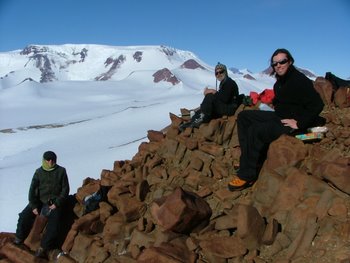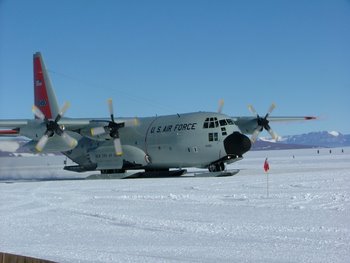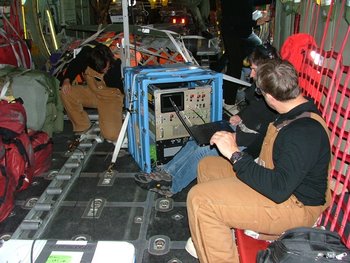When I was told to be flexible in Antarctica, they meant be FLEXIBLE! There are times when our weather delays have been an exercise in patience. That was certainly the case during our seven day wait on Mt. Hope. The day we had our reconnaissance flight to Shackleton Glacier also had an LC-130 Hercules coming into CTAM and returning the same day to McMurdo. We had been hopeful that we could do both the reconnaissance flight and return to McMurdo the same day. However, because of our delay until 2 p.m. for the Shackleton flight, we were not able to catch the Hercules back that same day (Wednesday 1-12).
 Lunch break from fossil hunting in the hills outside of CTAM. My collecting companions are from left to right: Kathy, Ed, Danny.
Lunch break from fossil hunting in the hills outside of CTAM. My collecting companions are from left to right: Kathy, Ed, Danny.
The next scheduled Hercules was for Friday, 1-14. So, we waited. Fortunately, this gave me some extra time to explore the area around camp. Thursday, I went for a snow machine ride into the hills about five miles from CTAM with one of the camp cooks, Kathy; Ed Stump (a researcher who's been coming to Antarctica for almost 40 years!); and his graduate student, Danny. We had a magnificent time - the sun was out, there was no wind, and there were fossils to be found! We had to hike up a steep slope made of shale, but the reward was at the top - Glossopteris fossils. The ones I found are by no means museum quality; actually, many of them are faint and somewhat difficult to see. However, they were especially exciting for me to find because they are a key fossil that provided evidence for the theory of plate tectonics.
 Looking for Glossopteris fossils in the foothills east of CTAM. (left to right: Ed, me, Danny)
Looking for Glossopteris fossils in the foothills east of CTAM. (left to right: Ed, me, Danny)
On Friday morning, the weather was beautiful at CTAM, but McMurdo was in the middle of a snow storm! So, once again, foiled by weather! Our next scheduled flight was for Saturday, January 15th. Had I known what an amazing flight was in store for us, I would have gladly waited the extra day. What a surprise we got when the announced plans for our return flight on Saturday morning. The Hercules that came to get us had been retrofitted with a special bubble window in the side of the plane and a radar detection system. The flight would take an extra two hours to complete because they would be flying low and slow over the glaciers on the way back to McMurdo. The project is a special crevasse detection project jointly operated between the military and Sandia National Laboratories. They are investigating how well ground penetrating radar can detect crevasses. Their project has two important components: the scientists on the ground at CTAM went out to a crevasse field and placed reflector plates at known depths inside a "textbook" crevasse; then the plane flew over them, using the radar to measure the depth of the crevasses.
 Here you're looking down into a 37 foot deep crevasse with the reflector plate is hanging 5 feet into it.. On the lower portion of the photo you can see the head of the mountaineer's ice ax for scale. Photo courtesy of Matthew Smith.
Here you're looking down into a 37 foot deep crevasse with the reflector plate is hanging 5 feet into it.. On the lower portion of the photo you can see the head of the mountaineer's ice ax for scale. Photo courtesy of Matthew Smith.
 Our LC-130 Hercules taxiing in from the skiway at CTAM
Our LC-130 Hercules taxiing in from the skiway at CTAM
 Maurice Conway standing in the bubble window taking photos of the mountains.
Maurice Conway standing in the bubble window taking photos of the mountains.
Unfortunately, once the plane took off, the scientists had problems with their radar instruments. We circled over CTAM for about 45 minutes before they conceded defeat and pulled up their radar. Luckily for us, they felt it was easier to stick with the flight plan than radio in and alter it, so they flew the pre-planned route back to McMurdo. We flew down the glacial valleys and along the front of the Transantarctic Mountains at a speed of 200 knots (1 knot = 1.2 miles) and at an altitude of 4,000-5,000 feet! What a treat! Very, very rarely do planes of this size fly so low and slow.
 View of CTAM from the air. Tent city is the square of dots on the right. Cargo is at the top of the photo. The long yellow object in the lower center is the galley. A portion of the skiway is on the left.
View of CTAM from the air. Tent city is the square of dots on the right. Cargo is at the top of the photo. The long yellow object in the lower center is the galley. A portion of the skiway is on the left.
 Scientists working with the radar on the crevasse study on our flight back from McMurdo.
Scientists working with the radar on the crevasse study on our flight back from McMurdo.
Three and a half hours later, we arrived at Pegasus Runway. It was an amazing flight and while I appreciated the once-in-a-lifetime opportunity, it felt good to be back to "civilization".
 View of the Transantarctic Mountains from the bubble window in the side of the LC-130 Hercules. The bubble extended so far out the side of the plane that you could easily look along the side of the plane.
View of the Transantarctic Mountains from the bubble window in the side of the LC-130 Hercules. The bubble extended so far out the side of the plane that you could easily look along the side of the plane.
